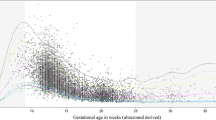Abstract
This study examined possible relationships between homocysteine and markers used in first-trimester screening for Down syndrome. Pregnancies were categorized into 4 groups according to quartile ranking of maternal plasma homocysteine concentration. Of the 595 pregnancies, 147 were assigned to group 1 (homocysteine level 0.6–3.5 μmol/L), 156 to group 2 (homocysteine level 3.6–4.5 μmol/L), 142 to group 3 (homocysteine level 4.6–5.6 μmol/L), and 150 pregnancies to group 4 (homocysteine level 5.7–12.6 μmol/L). No significant difference in mean nuchal translucency and mean free β-human chorionic gonadotropin (free-βhCG) multiples of the median (MoM) levels were observed. However, the mean pregnancy-associated plasma protein A (PAPP-A) MoM levels were significantly decreased in inverse relationship with homocysteine level among all 4 groups (F = 31.127, P < .001). If homocysteine is assayed as part of the first-trimester maternal serum testing, it is important to adjust for homocysteine concentration when using PAPP-A serum level for calculating the risk of fetal aneuploidy.
Similar content being viewed by others
References
Shaw SW, Hsu JJ, Lee CN, et al. First- and second-trimester Down syndrome screening: current strategies and clinical guidelines. Taiwan J Obstet Gynecol. 2008;47(2):157–162.
Gagnon A, Wilson RD, Audibert F, et al. Society of Obstetricians and Gynaecologists of Canada Genetics Committee. Obstetrical complications associated with abnormal maternal serum markers analytes. J Obstet Gynaecol Can. 2008;30(10):918–949.
Wu AH. Markers for early detection of cardiac diseases. Scand J Clin Lab Invest Suppl. 2005;65(suppl 240):112–121.
Wierzbicki AS. Homocysteine and cardiovascular disease: a review of the evidence. Diab Vasc Dis Res. 2007;4(2):143–150.
Daly S, Cotter A, Molloy AE, Scott J. Homocysteine and folic acid: implications for pregnancy. Semin Vasc Med. 2005;5(2):190–200.
Cheng PJ, Liu CM, Chueh HY, Lin CM, Soong YK. First-trimester nuchal translucency measurement and echocardiography at 16 to 18 weeks of gestation in prenatal detection for trisomy 18. Prenat Diagn. 2003;23(3):248–251.
Cheng PJ, Chang SD, Shaw SW, Soong YK. Nuchal translucency thickness in fetuses with chromosomal translocation at 11–12 weeks of gestation. Obstet Gynecol. 2005;105(5 pt 1):1058–1062.
Cheng PJ, Shaw SW, Soong YK. Association of fetal choroid plexus cysts with trisomy 18 in a population previously screened by nuchal translucency thickness measurement. J Soc Gynecol Investig. 2006;13(4):280–284.
Lawrence JB, Oxvig C, Overgaard MT, et al. The insulin-like growth factor (IGF)-dependent IGF binding protein-4 protease secreted by human fibroblasts is pregnancy-associated plasma protein-A. Proc Natl Acad Sci U S A. 1999;96(6):3149–3153.
Graham I. Homocysteine in health and disease. Ann Intern Med. 1999;131(5):387–388.
Kluijtmans LA, Young IS, Boreham CA, et al. Genetic and nutritional factors contributing to hyperhomocysteinemia in young adults. Blood. 2003;101(7):2483–2488.
Kim KN, Kim YJ, Chang N. Effects of the interaction between the C677T 5,10-methylenetetrahydrofolate reductase polymorphism and serum B vitamins on homocysteine levels in pregnant women. Eur J Clin Nutr. 2004;58(1):10–16.
Tanaka T, Scheet P, Giusti B, et al. Genome-wide association study of vitamin B6, vitamin B12, folate, and homocysteine blood concentrations. Am J Hum Genet. 2009;84(4):477–482.
Selhub J. Folate, vitamin B12 and vitamin B6 and one carbon metabolism. J Nutr Health Aging. 2002;6(1):39–42.
Graham CH, Hawley TS, Hawley RG, et al. Establishment and characterization of first trimester human trophoblast cells with extended lifespan. Exp Cell Res. 1993;206(2):204–211.
Dugoff L, Hobbins JC, Malone FD, et al. First-trimester maternal serum PAPP-A and free-beta subunit human chorionic gonadotropin concentrations and nuchal translucency are associated with obstetric complications: a population-based screening study (the FASTER Trial). Am J Obstet Gynecol. 2004;191(4):1446–1451.
Spencer CA, Allen VM, Flowerdew G, Dooley K, Dodds L. Low levels of maternal serum PAPP-A in early pregnancy and the risk of adverse outcomes. Prenat Diagn. 2008;28(11):1029–1036.
Dodds L, Fell DB, Dooley KC, et al. Effect of homocysteine concentration in early pregnancy on gestational hypertensive disorders and other pregnancy outcomes. Clin Chem. 2008;54(2):326–334.
Hoque MM, Bulbul T, Mahal M, Islam NA, Ferdausi M. Serum homocysteine in pre-eclampsia and eclampsia. Bangladesh Med Res Counc Bull. 2008;34(1):16–20.
Scholl TO, Johnson WG. Folic acid: influence on the outcome of pregnancy. Am J Clin Nutr. 2000;71(5 suppl):1295S–1303S.
Tul N, Pusenjak S, Osredkar J, Spencer K, Novak-Antolic Z. Predicting complications of pregnancy with first-trimester maternal serum free-betahCG, PAPP-A and inhibin-A. Prenat Diagn. 2003;23(12):990–996.
Smith GC, Shah I, Crossley JA, et al. Pregnancy-associated plasma protein A and alpha-fetoprotein and prediction of adverse perinatal outcome. Obstet Gynecol. 2006;107(1):161–166.
Pilalis A, Souka AP, Antsaklis P, et al. Screening for pre-eclampsia and fetal growth restriction by uterine artery Doppler and PAPP-A at 11–14 weeks’ gestation. Ultrasound Obstet Gynecol. 2007;29(2):135–140.
Bartels I, Thiele M, Bogart MH. Maternal serum hCG and SP1 in pregnancies with fetal aneuploidy. Am J Med Genet. 1990;37(2):261–264.
Hay DL. Placental histology and the production of human choriogonadotrophin and its subunits in pregnancy. Br J Obstet Gynaecol. 1988;95(12):1268–1275.
Author information
Authors and Affiliations
Corresponding author
Rights and permissions
About this article
Cite this article
Cheng, PJ., Huang, SY., Shaw, SW. et al. Maternal Homocysteine Level and Markers Used in First-Trimester Screening for Fetal Down Syndrome. Reprod. Sci. 17, 1130–1134 (2010). https://doi.org/10.1177/1933719110378345
Published:
Issue Date:
DOI: https://doi.org/10.1177/1933719110378345




